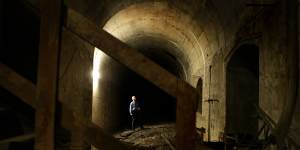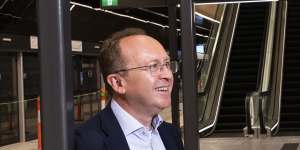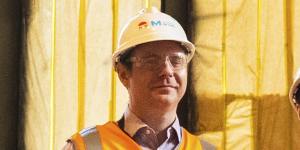As the new metro line opens under the heart of Sydney,we take a look at how it became a reality.See all19stories. Built directly above tunnels dug for Sydney’s Eastern Suburbs rail line,passages completed in the 1970s would become Central Station’s ghost platforms in the years that followed.
For decades,they lay empty despite being created to one day become part of another rail line. They were seriously considered during the early planning for a new metro rail project under the heart of the city as a location for platforms for driverless trains at Sydney’s busiest station.
Yet major obstacles derailed the plans for the never-used platforms 26 and 27.

The ghost tunnels at Central Station before they were used as a space for equipment for the new metro line.Credit:Kate Geraghty
While the prospect of trains one day passing through them has faded,the ghost platforms at Central have found a new use as the home for critical equipment for the$21.6 billion Metro City and Southwest project.
The ghost platforms are a tiny part of kilometres of rail and road tunnels that dissect the sandstone beneath Sydney’s CBD,making it resemble Swiss cheese. The underworld is also crisscrossed by pedestrian links,building basements and passages for utilities. Adding to the labyrinth beneath city streets,giant excavators are now working around the clock to carve out twin tunnels for the$25 billion Metro West rail line due to open in 2032.
Sydney Metro chief executive Peter Regan says planners looked at using the ghost platforms at Central as a stop for the City and Southwest rail project but decided against it because it was too far east for the new line’s alignment under the CBD.
Connecting the ghost platforms via tunnels to the north would also have meant the rail link would have run into building basements.
“We just couldn’t get the connection right in terms of the alignment,” he recalls. “It was decided it would be a much better interchange if[the new metro platforms were] ... smack bang in the middle of Central,so every platform can easily access it.”
To create a larger open space for the metro platforms,much of the heavy kit needed to operate them including transformers and control and power systems has been installed in the ghost platforms.
In the early days of the project,engineers weighed up digging a massive hole beneath Railway Square,on the western side of Central Station,as a site for the metro platforms. It was considered because there had been concerns about the greater cost and risk of excavating directly under Central and the major arteries of Sydney’s rail network.
“We were very nervous about tunnelling underneath[the main system],” recalls Rodd Staples,a former Transport chief regarded as the architect of the metro network. “But when you sat down and put yourself in the shoes of the customer,it was really the obvious choice.”
North of Central Station,the tunnels for the new metro line had to be threaded around and over obstacles. For much of the way,they run under Pitt and Castlereagh streets to avoid deep building basements. Similarly,the tunnels for Metro West’sonly underground station in the CBD closely follow the alignment of Hunter Street.
The Metro City and Southwest rail tunnels pass 4.6 metres above the Metro West rail tunnels and just 1.2 metres below a pedestrian walkway passage that will join Martin Place metro station to a new metro station being built under Hunter Street.

Sydney Metro chief executive Peter Regan on the new underground driverless train platforms at Central Station.Credit:Louise Kennerley
The two new lines also have to avoid running into each other. In the northern part of the CBD,the tunnels for the Metro West station run under those for the Metro City and Southwest line at Martin Place.
Sydney Metro City and Southwest project director Hugh Lawson says designers tried to ensure as best they could that the alignment of the tunnels followed under CBD streets to avoid deep building basements.
Loading
It also resulted in avoiding the need to build stations deeper below the surface,which would have led to longer walks for commuters to get to and from platforms from streets above.
“The deeper the tunnels are,the deeper the stations,” Lawson explains. “The deeper the stations are,the more you’ve got to build,the longer it takes to get passengers in and out the station. Generally speaking,we’re trying to keep those stations at a sensible depth. We don’t want them to be super,super deep.”
Metro stations and tunnels in the CBD are each about 20 to 30 metres below the surface.
Challenges mount for engineers once tunnels reach depths of 40 metres. At North Sydney,the northern end of theVictoria Cross metro station is about 50 metres below the surface due to the area’s hilly topography while the southern end is about 31 metres down. To overcome the depth,the project team opted for lift-only access at the northern end.
“As we have seen at Victoria Cross,you start moving to look at different ways to get people in and out of the station,” Lawson says.
While better for commuters,a shallower station can mean the gradient of the underground line is steeper for trains. The high elevation of North Sydney relative to the nearby harbour,which the line had to run under,presented major challenges for engineers designing Victoria Cross station and the railway’s route.
“You’re trying to aim for the best balance of the overall alignment. How steep the tracks are will also limit or dictate how fast the trains can run,” Lawson says. “We’re trying to keep the journey time short. You’ve got all of these multiple factors coming together about the practicality of building it.”
Deciding on the alignment of the line beneath the city was one of the first major pieces of the design work locked in early for the mega project. “That dictates where you build the tunnels,and it dictates all the design of the stations that follows,” he says.
In the CBD,theCross City Tunnel was one of the major barriers for thenew Gadigal station near Town Hall. Engineers decided to build tunnels for the metro line over the east-west toll road which opened in 2005.
Near the new Martin Place station,the heritage,brick-lined Tank Stream and major electrical and gas utility routes were the main underground obstacles for the metro tunnels.
“We’ve kind of intersected with pretty much every critical utility network through the CBD in one location or another,” Lawson says.
“We’ve had to manage around really important utilities that most people probably don’t realise are underneath their feet,but they power the city,they supply water to the city,and the CBD wouldn’t be able to operate without them.”
Known as a binocular station,thenew Martin Place hub was built by excavating tunnels directly under Pitt and Castlereagh streets for the platforms. The method is different from those for stations outside the CBD such as atWaterloo in the inner south,which was created by excavating one large hole from the surface.
“If we were to build a box station in the middle of the city it would be 40 metres underground,and you’d have to demolish everything on top of it,” says Luke Garden,who oversaw the new Martin Place station. “We’ve made a conscious choice here to put the tunnels under the roadways to avoid those basements.”
The Eastern Suburbs railway tunnels presented another obstacle the project team had to avoid for the metro line and Martin Place station.

Sydney Metro City and Southwest project director Hugh Lawson,left,and Martin Place station delivery director Luke Garden.Credit:Rhett Wyman
The existing rail tunnels curve across the southern section of the new Martin Place station site. Some of the huge columns supporting new office towers above the station are piled directly between the two Eastern Suburbs tunnels.
“It was an engineering challenge to get that perfectly right,” Garden recalls.
Start the day with a summary of the day’s most important and interesting stories,analysis and insights. Sign up for our Morning Edition newsletter.